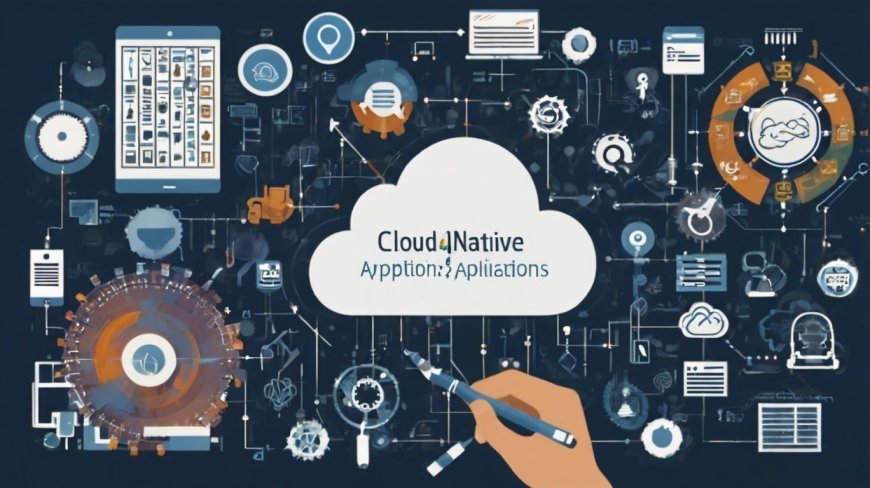The Evolution of Cloud-Native Applications
Explore the evolution of cloud-native applications and their benefits in terms of scalability, flexibility, and efficiency. Learn how businesses are adopting containerization, microservices, and serverless architectures

The Evolution of Cloud-Native Applications
Cloud-native applications have emerged as a transformative force in software development, enabling businesses to build, deploy, and scale applications with unprecedented efficiency and agility. Leveraging modern technologies such as containerization, microservices, and serverless computing, cloud-native applications are designed to maximize the benefits of cloud platforms. As businesses increasingly adopt digital transformation strategies, the evolution of cloud-native applications is reshaping industries and setting new standards for innovation.
This blog explores the concept of cloud-native applications, their evolution, benefits, challenges, and future trends.
What Are Cloud-Native Applications?
Cloud-native applications are software systems specifically designed to run in cloud environments. Unlike traditional monolithic applications, cloud-native applications are built using modern architectural approaches that emphasize scalability, resilience, and automation.
Key Features of Cloud-Native Applications:
-
Microservices Architecture: Applications are composed of small, independent services that can be developed, deployed, and scaled individually.
-
Containerization: Containers package applications and their dependencies, ensuring consistency across development, testing, and production environments.
-
DevOps Practices: Continuous integration and continuous delivery (CI/CD) pipelines automate deployment and testing processes.
-
API-Driven Communication: APIs enable seamless interaction between microservices and external systems.
-
Serverless Computing: Applications dynamically scale and execute based on demand without requiring infrastructure management.
The Evolution of Cloud-Native Applications
-
Traditional Monolithic Applications
-
Early software systems were developed as monoliths, where all components were tightly coupled. These applications were difficult to scale and update.
-
-
Virtualization Era
-
The introduction of virtual machines (VMs) improved resource utilization by allowing multiple operating systems to run on a single physical server. However, VMs were resource-intensive and slower to deploy.
-
-
Containerization and Kubernetes
-
The emergence of Docker popularized containerization, enabling lightweight and portable application deployments. Kubernetes further revolutionized the space by automating container orchestration and scaling.
-
-
Microservices and Serverless Architectures
-
Businesses adopted microservices and serverless computing to achieve greater flexibility, scalability, and cost-efficiency.
-
-
Hybrid and Multi-Cloud Strategies
-
Organizations now leverage multiple cloud providers and on-premises systems to optimize performance, cost, and compliance.
-
Benefits of Cloud-Native Applications
-
Scalability
-
Cloud-native applications can scale horizontally to handle increased demand by adding more containers or instances.
-
-
Resilience
-
Built-in redundancy and failover mechanisms ensure high availability and fault tolerance.
-
-
Faster Time-to-Market
-
Automation and modular architecture enable rapid development and deployment cycles.
-
-
Cost Efficiency
-
Serverless models and resource optimization reduce operational costs.
-
-
Flexibility
-
Applications can be deployed across different cloud providers, avoiding vendor lock-in.
-
-
Improved Collaboration
-
DevOps practices and CI/CD pipelines foster collaboration between development and operations teams.
-
Challenges of Cloud-Native Applications
-
Complexity
-
Managing distributed systems and multiple microservices requires advanced expertise and tools.
-
-
Security Risks
-
Increased attack surface due to the use of APIs, containers, and third-party services.
-
-
Skill Gaps
-
Organizations may face challenges in finding skilled professionals with cloud-native expertise.
-
-
Cost Management
-
Improper resource allocation or overprovisioning can lead to unexpected expenses.
-
-
Integration with Legacy Systems
-
Migrating from monolithic applications to cloud-native architectures can be time-consuming and costly.
-
Best Practices for Developing Cloud-Native Applications
-
Adopt a Microservices Approach
-
Break down applications into smaller, independent services that can be developed and scaled independently.
-
-
Leverage Containers and Orchestration Tools
-
Use Docker for containerization and Kubernetes for managing and scaling containers.
-
-
Implement CI/CD Pipelines
-
Automate code integration, testing, and deployment to accelerate development cycles.
-
-
Focus on Security
-
Use tools like container security scanners, API gateways, and encryption to protect applications.
-
-
Monitor and Optimize
-
Use monitoring tools like Prometheus and Grafana to track performance and identify bottlenecks.
-
-
Embrace DevOps Culture
-
Foster collaboration between development, operations, and QA teams to streamline workflows.
-
Real-World Applications of Cloud-Native Technologies
-
E-Commerce
-
Cloud-native architectures enable e-commerce platforms to handle traffic spikes during events like Black Friday.
-
Example: Shopify uses Kubernetes to scale its infrastructure dynamically.
-
-
Streaming Services
-
Cloud-native solutions power video and music streaming platforms to deliver seamless user experiences.
-
Example: Netflix’s microservices architecture ensures high availability and fault tolerance.
-
-
Healthcare
-
Cloud-native applications enable real-time patient monitoring, telemedicine, and secure data sharing.
-
Example: Philips HealthSuite integrates IoT and cloud-native technologies for healthcare solutions.
-
-
Financial Services
-
Banks use cloud-native applications for fraud detection, transaction processing, and personalized customer services.
-
Example: Capital One leverages cloud-native technologies for its digital banking platform.
-
Future Trends in Cloud-Native Applications
-
AI and Machine Learning Integration
-
Cloud-native platforms will increasingly integrate AI/ML for predictive analytics and automation.
-
-
Edge Computing
-
Combining edge and cloud-native technologies will enable real-time processing for IoT applications.
-
-
Service Mesh Adoption
-
Service meshes like Istio will simplify microservices communication and improve security.
-
-
Serverless Evolution
-
Serverless computing will expand to support more complex and stateful applications.
-
-
Hybrid Cloud-Native Solutions
-
Businesses will adopt hybrid approaches to leverage on-premises and cloud-native benefits simultaneously.
-
Conclusion
The evolution of cloud-native applications represents a significant shift in how software is developed, deployed, and scaled. By embracing microservices, containers, and serverless computing, organizations can achieve unparalleled agility, resilience, and cost efficiency.
While challenges remain, the future of cloud-native technologies promises continued innovation, driven by advancements in AI, edge computing, and hybrid cloud strategies. Businesses that adopt cloud-native approaches today will be better positioned to navigate the complexities of tomorrow’s digital landscape and maintain a competitive edge.

 datawaves
datawaves 





